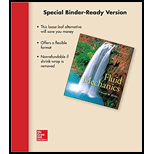
Professor Gordon Holloway and his student, Jason Bettle, of the University of New Brunswick obtained the following tabulated data for blow-dow n airflow through a converging- diverging nozzle similar in shape to Fig. P3.22. The supply tank pressure and temperature were 29 psig and 74°F, respectively. Atmospheric pressure was 14.7 psia. Wall pressures and centerline stagnation pressures were measured in the expansion section, which was a frustrum of a cone The nozzle throat is at v = 0.
| item) | 0 | 1.5 | 3 | 4.5 | 6 | 7.5 | 9 |
| Diameter (cm) | 1.00 | 1.098 | 1.195 | 1.293 | 1.390 | 1.488 | 1.585 |
| PwaiKpsig) | 7.7 | -2.6 | -4.9 | -7.3 | -6.5 | -10.4 | -7.4 |
| PsMglMIKHI (psig) | 29 | 26.5 | 22.5 | 18 | 16.5 | 14 | 10 |
Use the stagnation pressure data to estimate the local Mach number. Compare the measured Mach numbers and wall pressures with the predictions of one-dimensional theory. For.v > 9 cm. the stagnation pressure data was not thought by Holloway and Bettle to be a valid measure of Mach number. What is the probable reason?
Want to see the full answer?
Check out a sample textbook solution
Chapter 9 Solutions
Loose Leaf For Fluid Mechanics
- A hole is placed in the front of a cylinder to measure thestream velocity of sea-level fresh water. The measuredpressure at the hole is 2840 lbf/ft2. If the hole is misalignedby 12° from the stream and misinterpreted as stagnationpressure, what is the error in velocity?arrow_forwardYou wish to water your garden with 100 ft of 5/8-in-diameterhose whose roughness is 0.011 in. What will be the delivery,in ft3/s, if the gage pressure at the faucet is 60 lbf/in2?If there is no nozzle (just an open hose exit), what is thethe maximum horizontal distance the exit jet will carry?arrow_forwardThe converging–diverging nozzle shown in Fig. P3.22expands and accelerates dry air to supersonic speeds at theexit, where p 2 = 8 kPa and T 2 = 240 K. At the throat, p 1=284 kPa, T 1 = 665 K, and V 1 = 517 m/s. For steadycompressible fl ow of an ideal gas, estimate ( a ) the mass fl owin kg/h, ( b ) the velocity V 2 , and ( c ) the Mach number Ma 2 .arrow_forward
- The open stream of water seen in the following picture emerges from a nozzle into the atmosphere at sea level, where it then collides with a stagnation tube. If we exclude losses and assume that the pressure at the centerline of section 1 is 110 kPa, we can estimate that the (a) the mass flow measured in kilograms per second (kg/s), and (b) the height, measured in meters, of the fluid in the stagnation tube.arrow_forwardWater fl owing in a smooth 6-cm-diameter pipe entersa venturi contraction with a throat diameter of 3 cm.Upstream pressure is 120 kPa. If cavitation occurs in thethroat at a fl ow rate of 155 gal/min, what is the estimatedfl uid vapor pressure, assuming ideal frictionless fl ow?( a ) 6 kPa, ( b ) 12 kPa, ( c ) 24 kPa, ( d ) 31 kPa, ( e ) 52 kPaarrow_forwardConsider the Gulfstream IV flying at Mach = 0.35. Calculate thrust required given an altitude of 30,000-ft, assuming weight of 73,000-lb. Airplane data: S = 950 ft2, AR = 5.92, ??? = 0.015, and K = 0.08 a. The thrust required at 30,000-ft. (in pounds)arrow_forward
- In Fig. water exits from a nozzle into atmosphericpressure of 101 kPa. If the fl ow rate is 160 gal/min, what isthe average velocity at section 1?( a ) 2.6 m/s, ( b ) 0.81 m/s, ( c ) 93 m/s, ( d ) 23 m/s, ( e ) 1.62 m/sarrow_forwardLook up the word affinity in a dictionary. Why do you suppose some engineers refer to the turbomachinery scaling laws as affinity laws?arrow_forwardAir flows through a duct as in Fig, where A1 =24 cm2, A2 = 18 cm2, and A3 = 32 cm2. A normalshock stands at section 2. Compute (a) the mass flow,(b) the Mach number, and (c) the stagnation pressure atsection 3.arrow_forward
- Consider the Gulfstream IV flying at Mach = 0.8 at an altitude with atmospheric pressure of 33,283.40-Pa. Calculate thrust required assuming a weight of 73,000-lb. Airplane data: S = 950 ft2, AR = 5.92, CDo = 0.015, and K = 0.08. The thrust required. (in lbf)arrow_forwardIn Fig. P3.137 the piston drives water at 20 ° C. Neglectinglosses, estimate the exit velocity V 2 ft/s. If D 2 is furtherconstricted, what is the limiting possible value of V 2 ?arrow_forwardAir flows isentropically through a variable-area duct. Atsection 1, A1= 20 cm2, p1= 300 kPa, ρ1= 1.75 kg/m3, andMa1= 0.25. At section 2, the area is exactly the same, butthe flow is much faster. Compute (a) V2, (b) Ma2, (c) T2,and (d ) the mass flow. (e) Is there a sonic throat betweensections 1 and 2? If so, find its area.arrow_forward
 Elements Of ElectromagneticsMechanical EngineeringISBN:9780190698614Author:Sadiku, Matthew N. O.Publisher:Oxford University Press
Elements Of ElectromagneticsMechanical EngineeringISBN:9780190698614Author:Sadiku, Matthew N. O.Publisher:Oxford University Press Mechanics of Materials (10th Edition)Mechanical EngineeringISBN:9780134319650Author:Russell C. HibbelerPublisher:PEARSON
Mechanics of Materials (10th Edition)Mechanical EngineeringISBN:9780134319650Author:Russell C. HibbelerPublisher:PEARSON Thermodynamics: An Engineering ApproachMechanical EngineeringISBN:9781259822674Author:Yunus A. Cengel Dr., Michael A. BolesPublisher:McGraw-Hill Education
Thermodynamics: An Engineering ApproachMechanical EngineeringISBN:9781259822674Author:Yunus A. Cengel Dr., Michael A. BolesPublisher:McGraw-Hill Education Control Systems EngineeringMechanical EngineeringISBN:9781118170519Author:Norman S. NisePublisher:WILEY
Control Systems EngineeringMechanical EngineeringISBN:9781118170519Author:Norman S. NisePublisher:WILEY Mechanics of Materials (MindTap Course List)Mechanical EngineeringISBN:9781337093347Author:Barry J. Goodno, James M. GerePublisher:Cengage Learning
Mechanics of Materials (MindTap Course List)Mechanical EngineeringISBN:9781337093347Author:Barry J. Goodno, James M. GerePublisher:Cengage Learning Engineering Mechanics: StaticsMechanical EngineeringISBN:9781118807330Author:James L. Meriam, L. G. Kraige, J. N. BoltonPublisher:WILEY
Engineering Mechanics: StaticsMechanical EngineeringISBN:9781118807330Author:James L. Meriam, L. G. Kraige, J. N. BoltonPublisher:WILEY





